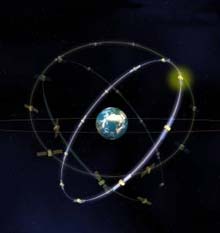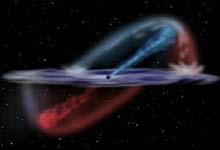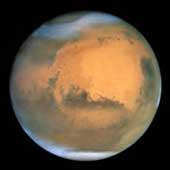Physics and Astronomy
This area deals with the fundamental laws and building blocks of nature and how they interact, the properties and the behavior of matter, and research into space and time and their structures.
innovations-report provides in-depth reports and articles on subjects such as astrophysics, laser technologies, nuclear, quantum, particle and solid-state physics, nanotechnologies, planetary research and findings (Mars, Venus) and developments related to the Hubble Telescope.

Jupiter`s Electric Aurora
The planet Jupiter has spectacular rings of auroras around each pole but until now scientists have not been able to explain how they form. All auroras are caused by energetic charged particles crashing into the top of the atmosphere and making it glow. In the Earth’s auroras, these particles come from the Sun in a flow of charged particles known as the solar wind. But this can’t account for Jupiter’s auroras because the solar wind does not reach to the region where the brightest are found. Space phys

Galileo gets the go-ahead
The European Space Agency warmly welcomes the decision taken today by the European Union Transport Ministers, meeting in Brussels.
Galileo has now been given the official go-ahead but for ESA that simply means that work on Galileo can continue! ESA teams have already been working for a number of years on satellite navigation systems, including the development of critical technologies such as atomic clocks and signal generators.
Developed by ESA in collaboration with the European U

Mystery of R Coronae Borealis and other helium stars solved
Astronomers Dr Simon Jeffery of the Armagh Observatory and Dr Hideyuki Saio of Tohoku University, Japan, have finally solved a long-standing mystery concerning the creation of two particular kinds of rare stars. They have found that a class of variable stars named after their prototype R Coronae Borealis (RCrB), and a related group called `extreme helium stars` are the products of mergers between pairs of white dwarf stars. What kind of star results from the merger depends on the composition of the w

Gemini Observatory Probes Galaxy’s Churning Core
Astronomers using the Gemini North Telescope on Hawaii’s Mauna Kea report that they have created a three-dimensional movie of a powerful, active galaxy located some 70 million light years away. The addition of a new instrument, the Integral Field Unit (IFU), to the Gemini telescope enabled the group to study light from the galaxy NGC1068 in much greater detail. From a single still of NGC1068, the IFU generated data on the physical conditions and velocities of galactic material throughout the image.

Height ices Mars on top
Martian atmosphere churns harder in south making north wetter.
Scientists have figured out why it’s wet up north – on Mars. A new computer simulation of the martian atmosphere suggests that the planet’s geography causes differences in atmospheric circulation within the northern and southern hemispheres. These differences dump more water on the martian north pole, where it adds to the seasonal ice-cap.
Mark Richardson of the California Institute of Technology in Pasa

Violent galaxy seen in 3-D
Astronomers at the Gemini telescope in Hawaii have obtained a complete, multi-dimensional picture, of the dynamic flow of gas and stars at the core of an active galaxy [NGC 1068] located 70 million light years away. The image was achieved in a single snapshot and is the first time such a picture has been obtained by one of the new generation of giant telescopes with an 8 – 10 metre light collecting mirror. The astronomers used a new instrument – the Integral Field Unit (IFU), designed and built at Du